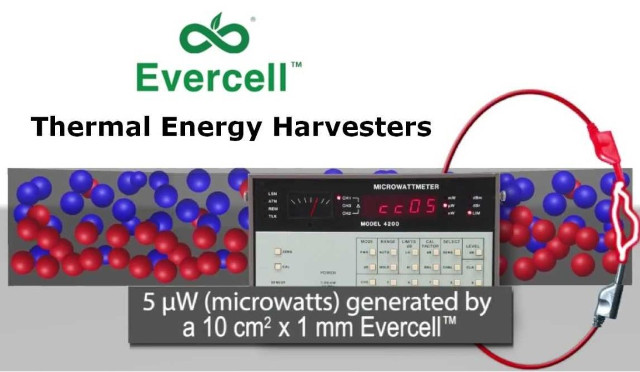In order to be successful the Internet of Things needs to be extremely inexpensive per node, and the problem is that most remote sensors are non powered by batteries, which either needs to be replaced or recharged, which involve maintenance costs. One ideal solution is battery-less IoT sensor nodes, that do not need any battery, and instead rely on energy harvesting.
The idea is easier said that done, especially if you intend to do it cheaply. While there have been solutions provided over the years for example using vibration energy harvesting or water flow, battery-less devices are still not that common, but companies still bring new energy harvesting devices to market. One of those is Face International’s Evercell thermal energy harvester that leverages the temperature difference within a material to generate electricity, as long as ambient temperature is above absolute zero.
 The company plans to manufacture various models of their harvester with different capacities, size, and thickness, for example (expected features/performance):
The company plans to manufacture various models of their harvester with different capacities, size, and thickness, for example (expected features/performance):
- 5μW device
- 34mm x 34mm x 1mm
- 1.2V output
- 4.2μA continuous current
- 480-nW device
- 30mm x 30mm x 0.2mm
- 1.2V output
- 400nA continuous current
- 960-nW device
- 50mm x 75mm x 0.1mm
- 1.2V output
- 800nA continuous current
The video embedded below shortly explains how the technology works.
Face has partnered with BRIDG, an industry-led public-private partnership for advanced technologies and manufacturing processes, in order to further develop and manufacture the Evercell power cell. In the press release, we learn that an Evercell prototype has already been tested for 16 months with undiminished performance, and producing enough electrical output to power a typical wireless sensor. Furthermore, Evercell power cells are said to be “inexpensive to produce, consume no fuel, have no moving parts, and contain no toxic materials”. If the collaboration produces the expected results, mass production should start in 2019 at BRIDG facility located in NeoCity, Florida in the US. Further information may be found in Face’s Evercell product page.

Jean-Luc started CNX Software in 2010 as a part-time endeavor, before quitting his job as a software engineering manager, and starting to write daily news, and reviews full time later in 2011.
Support CNX Software! Donate via cryptocurrencies, become a Patron on Patreon, or purchase goods on Amazon or Aliexpress






You can build cheap DIY thermoelectric power generator yourself using one or multiple peltier:
https://en.wikipedia.org/wiki/Thermoelectric_generator
Combine this with a voltage regulator and a capacitor or battery then heat is all you need.
Google “thermoelectric generator” and there are plenty of tips for DIY builds based on cheap peltier elements from China.
This is not as good as it seems. First, a ten cent coin cell will last six years at the same current draw. Second this device has no peaking power. When your radio turns on it need a lots more power for a brief period of time. A battery can easily supply that, this device can’t do that so easily. With more research something like this might be useful, but right now I’d say stick with the ten cent coin cell.
@Jon : you havent read the entire presentation or dont understand what “energy harvester” are. Dont use them as a battery but instead like a charger. Use a capacitor or super capacitor to store energy produced by harvester, ans use it when needed.
@Singman
They aren’t harvesting enough energy to be interesting. IOT SOCs have two power draws – a tiny trickle of standby current and a much larger current when they turn the radio on to transmit. Trying to maintain the standby current and simultaneously charge a battery/super cap with the available current is going to be might tricky. Add up the power output; it takes the largest cell six years to output the energy stored in a ten cent coin cell. And that assumes there is sufficient thermal gradient to achieve continuous full power output from the cell. I’m not saying these things don’t work, I just don’t think they are worth the trouble compared to a coin cell.
University of Washington has built a similar energy harvester that harvests radio energy. But it has the same drawback, the amount of power it makes is minuscule.
If you want a workable energy harvester use a solar cell and find someplace with direct sun exposure.
Jon,
I don’t think you understand this well enough. As the IoT expands it cannot possibly reach its potential with coin batteries. There is no way that all of them can be maintained or replaced year after year. To conceive of a network of billions of sensors deployed worldwide and having to change batteries as such sensors go down is virtually impossible without such an invention. This seems to be the solution to the 800lb gorilla the IoT faces.
If you take a look a this company’s past products it appears they have a great deal of experience with devices in wireless transmissions. I would imagine they already have a solution to address your concerns.
@Jon Smirl
You are correct, too little power from the thermoelectric generators makes it not so practical, I would prefer solar cells or peizo electric generators
@Chris
Check out the Enocean stuff for something that is known to work.
https://www.enocean.com/en/enocean_modules/details/edk-312/
These things are in the $30 range per device.
And they are very limited in what they can do.